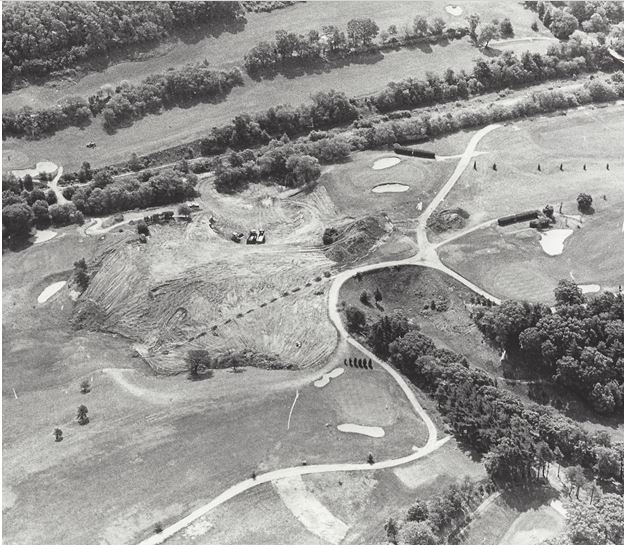The Monster Divot
By
Dennis C. Orvis
In 1979 there were many problems at the Fall River (Massachusetts) Country Club.
I had been manager of the Fall River Chamber of Commerce for ten years. My wife and I had been members of the Country Club since August, 1969, when we moved to Fall River.
The Fall River Country Club had quite a history. It was constructed in 1895, making it one of the oldest golf courses in the United States. It was built on a Scottish-lay-of-the-land style of golf course, along a beautiful part of the Taunton River.
It had two big problems. First it was built on a piece of land that could be classified as almost too small for a nine-hole golf course. It was bordered on one side by the river and on the other side by a railroad track. There was no hope for an expansion to eighteen holes.
The other problem was low membership and money. The original course was built in good times by the leaders of the business community, community leaders. Then around 1922, over one hundred cotton and garment factories moved south to the Carolinas, Georgia and Alabama. The city fell into financial chaos and went bankrupt. Then tragedy upon tragedy, the Great Depression of 1929 hit the Nation. The State of Massachusetts took over the finances of the city. Maintenance stopped and the population dropped by more than 50,000 people.
Through this the Country Club survived somehow, although most businessmen who played golf joined other golf courses in southern Massachusetts and Rhode Island, which were less than twenty miles away.
The membership, with few exceptions, was made up of working people and finances continued to be a difficult problem.
Sometime in the 1960’s, a Federal government project to dredge out the channel serving Fall River’s deep water port was completed. Much of the material dredged out of the channel was deposited along the shore of the Fall River County Club. This new land made it possible to turn the nine-hole golf course into an eighteen-hole golf course. Arrangements were made with the assistance of most of the Fall River banks to do the project.
There was an abandoned rock quarry at the far end of the golf course north and on the other side of the railroad tracks. It was learned the quarry was for sale. The Country Club was very interested because there was enough land in the quarry to design two new holes of golf.
The Country Club board of directors asked or appointed one of its members to meet with the quarry owners and buy the property for the expansion of the golf course. I don’t know if that person was a member of the board or not, but if he was it would make this situation even worse.
This is why. That person bought the quarry land and kept it for himself, instead of buying it for the Country Club. He re-opened the quarry and probably did very well financially.
What a fiasco.
The Country Club board (and membership) voted to expand the golf course to eighteen holes. In order to accomplish this, they leased enough land on the other side of the railroad tracks (not the quarry land) to design and add two holes. This was necessary, since there was only enough land, with the addition of the dredging material to build seven new holes. They hired a well-known New England golf course architect to do the design of the new nine holes.
When I arrived in the fall of 1969, the Fall River Country Club was an eighteen hole golf course and still struggling financially. The membership did not grow as expected after it became an eighteen hole golf course. My wife and I were playing members but I did not get involved with the Clubs problems, I had enough of my own problems trying to rebuild the Chamber of Commerce.
Then, I guess it was maybe 1978 when a friend was elected to be the President of the Country Club. He asked a mutual friend to be the chairman of the Green’s Committee. The role of this committee is to oversee the work of the course superintendent and his crew, and to deal with golf course problems.
About three or four months later our mutual friend resigned as chairman of the Green’s Committee in disgust. There wasn’t enough money and there were problems with the employees of the golf course.
My friend, the Club President then asked me to be the Green’s Committee chairman.
Frankly, I had enough problems running the Chamber of Commerce, I didn’t need any more.
In fact, I had a couple good Chamber supporters who suggested strongly I shouldn’t get involved with the Country Club problems.
I felt however, the need and the challenge were both great. I looked at it as just “another” chamber-type community improvement project. It was my belief that a good golf course helps to attract new business and industry, many businessmen are also golfers.
So I said yes and became the chairman of the Green’s committee for the Country Club.
With the limited funds available, I hired a bunch of young people to cut brush, small trees and in general, clean up the golf course and make it prettier.
I also went hole by hole on the course and came up with a list of thirty-three projects that I thought would improve the golf course. Most of the projects could be done with minimal expense. Some of my suggestions had to be approved by the golf course architect and they were. The smallest project was to cut down a tree that was too close the tee on the 18th hole. On the right side the fairway was lined with trees with a deep valley behind them. It was a horrendous tee for most amateurs, especially the slicers that had no place to aim or hit.
The biggest project was to sell part of two fairways which were deep with gravel and could really help the country club in a big way financially.
About two months before the annual meeting of the members I sent a survey to every member explaining my proposed projects. I told them I would present the projects to the members for a vote at the annual meeting and would be requesting a “up or down vote” on each project.
I am sure you can guess we had a huge turnout at the annual meeting. I made my presentation one project at a time. I was pleasantly surprised when the members voted support for twenty-three of the thirty-three projects.
On the biggest project, the excavation of gravel, I told the members we had a gravel company do test borings and they concluded we could expect over 80,000 cubic yards of gravel to be recovered. This gravel could be sold for over $1.10 per cubic yard.
There was some historical knowledge that the glaciers actually melted in this area of Massachusetts. The test borings verified this possibility.
I told them this project could be done without harming either one of the two holes that would be involved.
Well, there were only two or three votes against the project. It was an overwhelming yes vote.
When the excavation was completed over 90,000 cubic yards of gravel was removed. It was said, “Orvis made the biggest divot in the history of the golf course since it was constructed.”
On the second hole, a par five, there was a long plateau for about 180 yards then it dropped down to a valley, all the way to an elevated green. What we did was remove the plateau, which meant the golfers simply teed off to a valley, which really did not change the hole’s distance and actually enhanced its beauty as the tee faced the water at the other end.
On hole number eight, a par three, the tee was level with the green, some 140 yards away. The project put a valley between the tee and the green. The distance was the same and the hole became a much pretty, challenging hole.
The members loved the improvement when it was finished, although we had more than one bucket brigade days to pick up little pebbles that were now on top of the fairways, even after the original black top soil was spread over the project area. Many members participated in this effort.
Here is a picture of the project.

At the top center of this picture you can see the equipment digging the new valley on the eighth hole, which goes left to right. The dotted line in the picture is the imaginary line between the 2nd and 8th holes. The 2nd hole goes right to left and the tee is in the upper right side of the picture. It is hard to believe that over 90,000 cubic yards of gravel came out of this hole. It is mind boggling to know that the entire golf course is built on pebbles from the melted glaciers centuries ago.
Well, the last time I saw this great old golf course, it was a showplace. The young man I hired to be the greens superintendent was still there. When I hired him I told him, “this is your golf course; make it as great and beautiful as you can with the little money we can provide.” I want to tell you he turned it into a great golf course. It really is a show place.
This is what happened after this project. The members voted to build a new clubhouse overlooking the Taunton River. The membership of the country club has grown. The last I heard there was a waiting list to join.
No, it wasn’t a Chamber of Commerce project, but I can assure you it served the same purpose.
I was chairman of the Green’s committee for only a couple years. Another project I liked was spearheaded by one of the members of my committee. He collected over five hundred dollars from some of his friends and buddies and we bought six old street lights from the local power company and installed them along the drive coming into the country club. I really like that touch. It gave it a little extra class. The light poles used to be in downtown Fall River, early 1900’s.
After two years, they selected another person to be the chairman. I think they were afraid I would try to sell a couple more fairways!
It would be great to play the old course once again for many reasons, more than you can imagine, perhaps more than 90,000.
February 2012
*****
